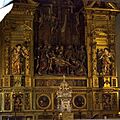Pedro Roldán facts for kids
Pedro Roldán (1624–1699) was a famous Baroque sculptor from Seville, Spain. He lived during a time known for its dramatic and detailed art. His daughter, Luisa Roldán, also became a very important sculptor. She was often called La Roldana.
Contents
Life of Pedro Roldán
Pedro Roldán was born in Seville in 1624. He was baptized on January 14, 1624. When he was 14, he moved to Granada. There, he became an apprentice to a sculptor named Alonso de Mena.
In 1642, Pedro married Teresa de Jesús Ortega y Villavicencio. She was probably Alonso de Mena's niece. Their first daughter, María, was born in Granada in 1644. When Alonso de Mena died in 1646, Roldán moved back to Seville. At this time, another great sculptor, Juan Martínez Montañés, was finishing his career. This created a chance for Roldán's art to shine.
In 1660, Pedro Roldán started teaching sculpture classes. He taught at the Academy of Art, which was started by the famous painter Bartolomé Esteban Murillo. In his later years, Roldán had a large art studio. He worked with his family, including his children and sons-in-law. His students also helped him.
His studio created and decorated altarpieces, which are large artworks behind church altars. They also made sculptures. Their projects reached many cities like Cádiz, Jerez de la Frontera, Córdoba, and Jaén. Pedro Roldán died in 1699. He was buried in the crypt of Saint Mark's Church in Seville. He was also good friends with another artist, Juan de Valdés Leal.
Roldán's Family of Artists
Pedro Roldán and his wife Teresa had eight children. All of them worked closely with him in his studio.
- Francisca Roldán (born 1650) helped paint the faces and hands of the sculptures. She married sculptor José Felipe Duque Cornejo. Their son, Pedro Duque y Cornejo, also became a famous sculptor.
- Luisa Roldán (born 1652) became one of the most important sculptors of her time. She was known as La Roldana. She married sculptor Luis Antonio de los Arcos.
- Maria Roldan (born 1654) also worked as a sculptor. She married sculptor Matías de Brunenque.
- Isabel Roldán (born 1657) was the goddaughter of Juan de Valdés Leal. She married Alejandro Martagón, who worked in Roldán's studio.
- Marcelino José (born 1662) took over the studio after Pedro Roldán died.
- Pedro de Santa María (born 1665) was also a sculptor.
Artistic Style
Pedro Roldán first learned a natural style of art. This means his sculptures looked very real. Over time, his art changed to the Baroque style. This style is known for being dramatic, emotional, and full of movement. Roldán developed his own unique style. It was elegant and very expressive in its forms.
Famous Sculptures
- Our Father Jesus Tied to the Column (1675): This sculpture is in Lucena.
- Most Holy Christ Tied to the Column: Found in La Orotava, Tenerife.
- Sculptural part of the altarpiece of Saint Ann's Church: Located in Montilla.
- Altarpiece of the Descent of the Biscayans: This is in the Church of the Sanctuary in Seville. Roldán created the sculpture of the Descent from the Cross.
- Altarpiece of the Entombment of Christ: This work is at the Hospital de la Caridad in Seville. It includes sculptures of Saint George, Saint Roch, and the Virgin of Charity.
- Sculptures of the Four Evangelists, the Four Doctors of the Church and Saint Ferdinand: These are on the front of the Cathedral of Jaén.
- Most Holy Christ of the Expiration: This sculpture is in Écija.
- Archangel Saint Michael (1657): Found in the Church of Saint Vincent, Seville.
- Reliefs of the Passion (1659): These are in the Church of Saint Mary Magdalene, Seville.
- Saint Ferdinand (1671): This sculpture is in the Cathedral of Seville.
- Saint Ann teaching the Virgin to read (1672): Located in the Church of the Holy Cross, Seville.
- Saint Ignatius Loyola (1672): In Saint Bartholomew's Parish Church, Seville.
- Saint Dionysius (1673–1674): Found in the Church of Saint Francis, Cádiz.
- Saint Remigius (1673–1674): Also in the Church of Saint Francis, Cádiz.
- Saint Peter and Saint Paul (1680): These are in the Parish Church of Villamartín, Cádiz.
- The Immaculate Conception (1680): In the Church of Our Lady of Grace, Córdoba.
- Reliefs of the Passion (1683–84): Found in Saint Catherine's Church, Seville.
- Saint Peter and Saint Ferdinand (1698): In the Church of the Hospital de los Venerables, Seville.
- Christ of the Descent: Located in the Church of Saint Mary Magdalene, Seville.
- Christ of the Pardon: In the Church of Santa María la Coronada, Medina-Sidonia.
- Our Lady of Antigua (1650–1655): In the Church of Saint Mary Magdalene, Seville.
- Santísimo Cristo de las Misericordias: This sculpture is from 1670–1682 and is thought to be by Pedro Roldán or his studio.
- The Virgin of Hope of Macarena: This famous statue was crowned by Pope John XXIII in 1964.
Images for kids
-
Christ of the Pardon, Church of Santa María la Coronada, Medina Sidonia.
-
Sculpture of King Ferdinand III of Castile (1671), Cathedral of Seville. The king, later known as Saint Ferdinand (Spanish: San Fernando) is represented with a sword in one hand and an orb in the other, both traditional symbols of power.
See also
 In Spanish: Pedro Roldán para niños
In Spanish: Pedro Roldán para niños









